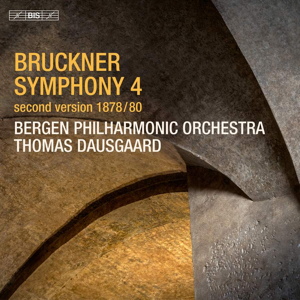
Anton Bruckner (1824-1896)
Symphony No. 4 in E-flat Major, “Romantic”, WAB 104 (Second Version, 1878-81*)
Bergen Philharmonic Orchestra/Thomas Dausgaard
rec. 2020, Grieghallen, Bergen, Norway
BIS BIS-2534 SACD [61]
I previously reviewed Dausgaard’s recording in this series of Bruckner’s Sixth quite positively, calling it “swift and sassy” – which I meant as a compliment, especially as it applies to “Die Kechste”. I also reviewed his account of the original version of the Third which I heartily disliked, so I approached this third instalment of the most frequently played version of the Fourth rather curious and fearing that Dausgaard would adopt the same slick and shallow approach which for me so compromised his Third Symphony. As usual with BIS, it is available in three audio versions: standard CD, high-resolution stereo, and high-resolution surround sound; I listened to the standard download and as with the preceding issues, the sound is exemplary. I especially like the division of the violins left and right and balances are perfect.
The opening horn call instantly puzzled me. I know Bruckner’s marking is “nicht zu schnell” and Dausgaard is clearly studiously observant of that instruction but it is preceded by the word “Bewegt” which means “with movement/moving” and that start is oddly static. Things soon pick-up but having just come from listening to how carefully in this symphony Blomstedt moulds phrases and grades dynamics in his 2010 recording with the Gewandhausorchester, I soon consigned Dausgaard to the “stop-go/soft-loud” category in comparison with Blomstedt’s subtlety. He is one who equates speed with excitement and at 61 minutes overall, this is one of the fastest – I would say too fast – performances in the catalogue. There is little time for shaping or nuance and details in the score are blithely skated over. The music seems to pass by non-eventfully, as if a computer programme were interpreting the score – faithfully and soullessly and as the listener I feel as if I am being hurried along on a Bruckner conveyor belt. The supposedly thrilling peroration concluding the first movement – graced, I concede by some very fine horn-playing – does not so much thrill as crudely shout; it is in fact too loud compared with what has come before – and it’s not often I make that complaint. In this, it seems my colleague and previous reviewer DP and I concur.
The timbre of the Bergen orchestra is lighter compared with some of the Big Beast conductors and orchestras who have played this symphony much more weightily and this undoubtedly suits Dausgaard’s literal interpretative stance, but it militates against the grandeur of Bruckner’s idiom.
The Andante is better paced but frankly, dull. The agitated, exactly centrally-positioned middle section is very loud then the movement just creeps softly and listlessly towards the final, incongruous explosion when at 12:36 Dausgaard again defaults to the ‘ending = suddenly-very-loud’ trick before an inconsequential coda. The Scherzo fares better but we hear more of the loud-soft method and there isn’t much bite to the articulation of the blaring hunting theme. The Trio isn’t very beguiling; bucolic charm and Viennese lilt are in short supply. Of course, the tense, restless finale responds best to Dausgaard’s vision and the Bergen orchestra makes an impressive racket during the introductory couple of minutes before the flowing main theme, and he sustains momentum through to the noble, declamatory conclusion – even if halfway through at 10:13 he succumbs to one of his periodic fits of hysteria. This is by far the most successful of the four movements here but insufficient to redeem the perfunctoriness which precedes it.
I appreciate that tastes in how Bruckner should be interpreted can vary and some might respond more enthusiastically than I to Dausgaard’s antiseptic, forensic manner but I cannot help but feel that many, greater interpreters find much more in this music than is revealed here.
*dating the symphony 1878-1881 rather than 1878/80 as per the cover description encompasses the premiere performance of this version in 1881.
Ralph Moore
Previous review: David Phipps (May 2023)
(This review reproduced here by kind permission of The Bruckner Journal)
Help us financially by purchasing from




















